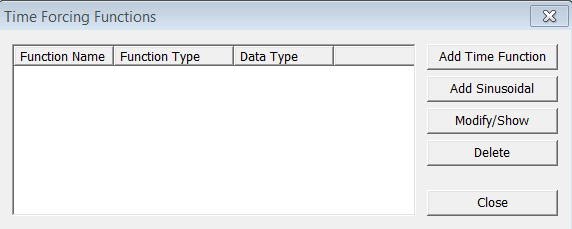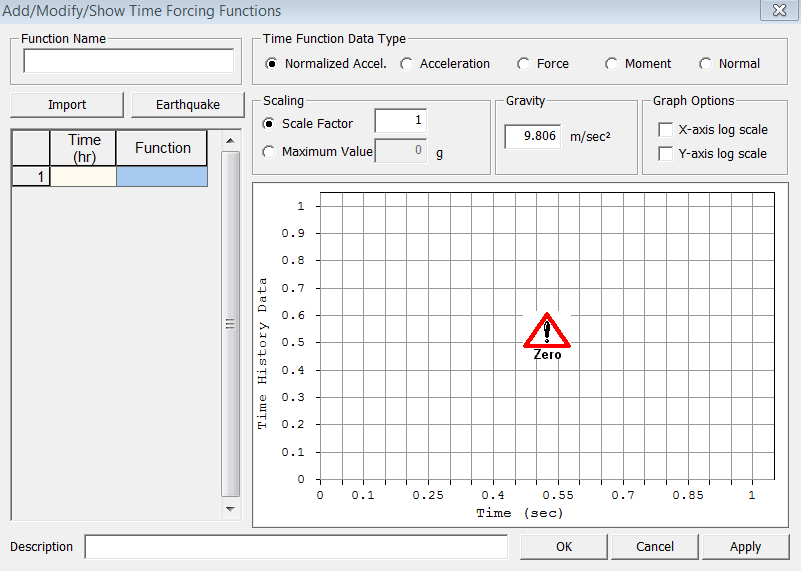Load: Time Forcing Functions

Function
Assign time forcing functions for time history analyses.
Call
Model > Load > Time History Analysis Data > Time Forcing Function
incomplete beta

<Time Forcing Function>
<Enter new or additional time forcing functions>
Click  when the time forcing
function is of random type or a walking load. Click
when the time forcing
function is of random type or a walking load. Click  when the time forcing
function is sinusoidal.
when the time forcing
function is sinusoidal.
<Modify previously entered time forcing functions>
Select a time forcing function from
the list in the dialog box and click .jpg) .
.
<Delete previously entered time forcing functions>
Select a time forcing function from
the list in the dialog box and click .jpg) .
.
Data entry method by clicking 

<Add/Modify/Show Time Forcing Function>
Function Name
Enter the name of the time forcing
function, which will be used for applying time history loads in Dynamic Nodal Loads , Ground Acceleration, or Time
Varying Static Loads. In the case of a walking load or earthquake
data, the name may be automatically selected.
Time Function Data Type
Select a type of
Time Function Data. When assigning dynamic nodal load, only Force or Moment
accelerations can by used for time forcing functions.
Normalized Accel.
Values obtained by dividing time history acceleration by the gravitational acceleration.
Acceleration
Time history acceleration.
Force
Force acceleration.
Moment
Moment acceleration.
Normal
Force or Moment is selected to enter the time history loads as dynamic nodal loads in the Dynamic Nodal Loads function.
Normalized Accel. or Acceleration is selected to enter the time history loads as ground accelerations in the Ground Acceleration function.
Normal is selected to enter the time
history loads as time dependent static loads in the Time Varying Static Loads
function.
Scaling
Scale Factor
Specify
a multiplier for Time History Data.
Maximum Value
Specify
the maximum spectrum value.
Gravity
Display the applied acceleration of
gravity, which may be revised in Project Setting.
Graph Options
Specify whether or not to generate
a Graph in Log Scale.
Description
Enter a brief description of Time History Function.
For convenience,
MIDAS/GTS supports the following 3 data entry methods:
Save and retrieve frequently used time history loads in and from files, respectively.
Access the built-in time history loads from the database.
The user directly enters the time function data.
1. Save and retrieve frequently used time history loads in and from files

Enter the time history loads by reading
previously created files. The data are saved with '.sgs' or '.thd' extension
and are written according to the following formats.
'fn.sgs' file type
|
*SGSw |
To define that the file is in "Seismic Data Generator" data format which is a MIDAS/Civil module that auto-extracts seismic data |
|
*TITLE, Elcentro 1940, N-S Component |
- |
|
*X-AXIS, Second |
- |
|
*Y-AXIS, Normalized Acceleration |
- |
|
*UNIT&TYPE, GRAV, ACCEL |
- |
|
*FLAGS, 0, 0 |
- |
|
*DATA |
- |
|
1.00000E-010, 3.50102E-001 |
- |
|
5.00000E-002, 3.82861E-001 |
- |
|
1.00000E-001, 5.08226E-001 |
- |
|
1.50000E-001, 5.17459E-001 |
- |
|
: |
- |
'fn.thd' file type
|
Option |
** Comments - Entry allowed anywhere |
|
- |
*UNIT, M , N - Length: MM, CM, M, INCH, FEET, GRAV allowed |
|
- |
하중 : KG, TON, KN, LBF, KIP |
|
- |
*TYPE, ACCEL - ACCEL, FORCE, MOMENT allowed |
|
Requirement |
*Data |
|
- |
X1 , Y1 (x : Time, X : Time Function) |
|
- |
X2 , Y2 |
|
- |
X3 , Y3 |
|
- |
: |
2. Access the built-in time forcing functions from the MIDAS/Civil database

Create time history loads by reading earthquake records from the database.
There are 32 types of built-in seismic accelerations in the database.

<Generate Earthquake Acceleration Record>
3. Enter directly the time forcing functions in the entry fields in the Add/Modify/Show Time History Functions dialog box
The user directly enters the time and the time forcing function values in the entry fields to the left of the dialog box
Data entry method by clicking 

<Add/Modify/Show Time Forcing Function>
Function Name
Enter the name of the time forcing
function, which will be used for applying time history loads in Dynamic Nodal Loads, Ground Acceleration or Time
Varying Static Loads.
Time Function Data Type
Assign the type
of data to be entered.
Normalized Accel
Values obtained by dividing the time history acceleration by the gravitational acceleration.
Acceleration
Time history acceleration
Force
Load (force)
Moment
When Force or Moment is assigned, the time forcing function is used to enter the Dynamic Nodal Loads.
When Normalized Accel. or Acceleration is assigned, it is used to enter the Ground Acceleration
When
Normal is assigned, a static load is defined to vary with time as a time
history load in Time
Varying Static Loads.
Parameters constituting the Sinusoidal Functions
A, C are constants, f is the frequency of excitation, D is the Damping Factor, PA is the Phase Angle.
When the time forcing function is entered in the form of a harmonic function, specify the parameters required in the Sinusoidal Function. Click Redraw Graph to display the graph of the forcing function to the right and click to save the time forcing function.